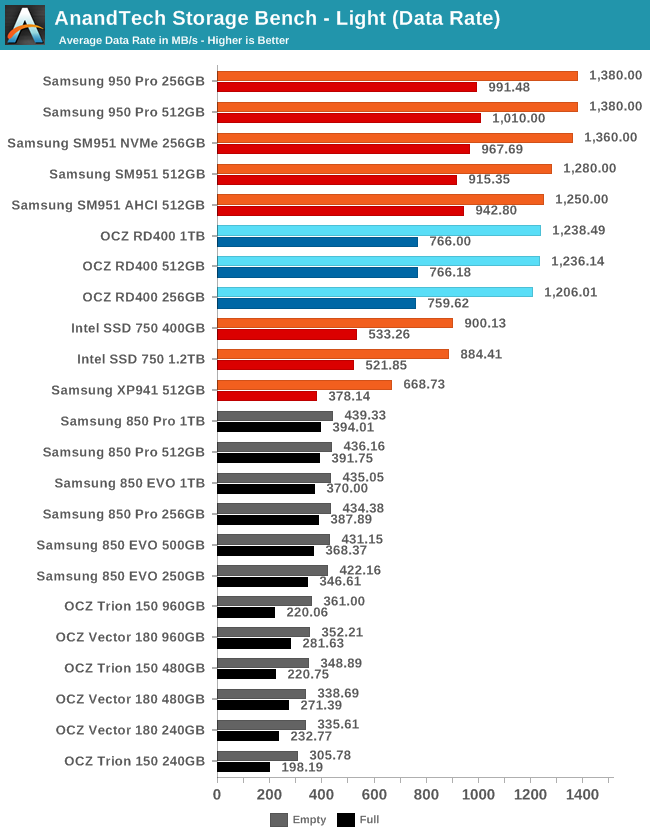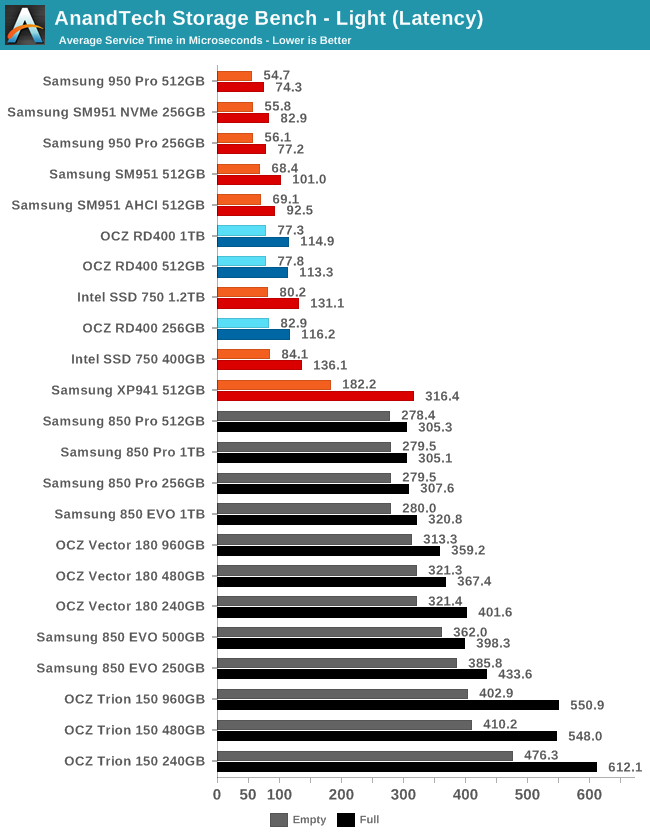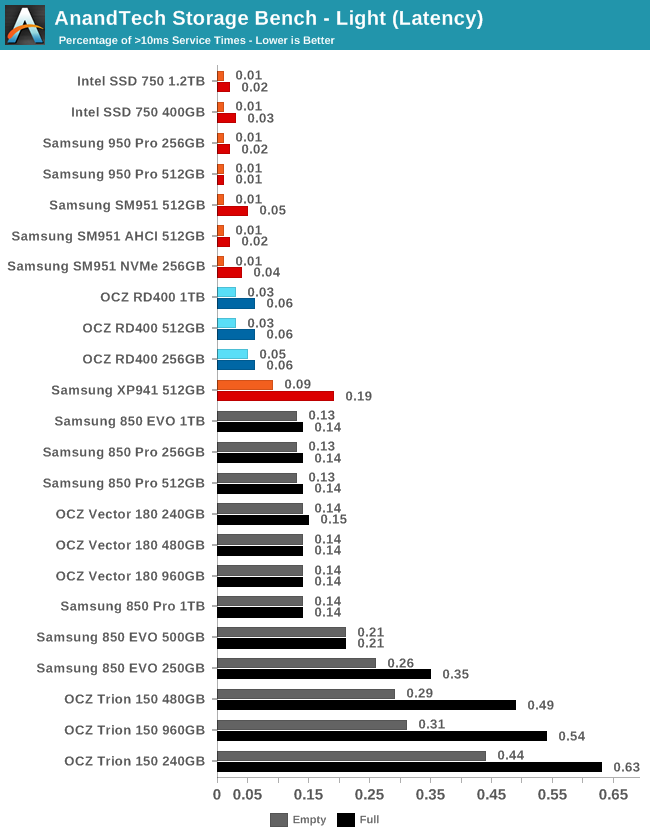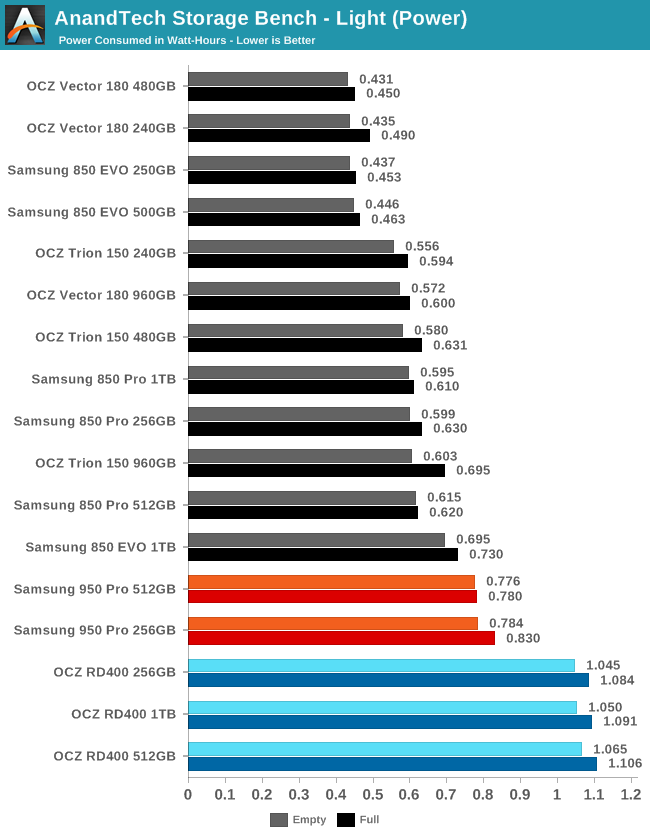The Toshiba OCZ RD400 (256GB, 512GB, 1TB) M.2 PCIe SSD Review
by Billy Tallis on May 25, 2016 8:02 AM ESTAnandTech Storage Bench - Light
Our Light storage test has relatively more sequential accesses and lower queue depths than The Destroyer or the Heavy test, and it's by far the shortest test overall. It's based largely on applications that aren't highly dependent on storage performance, so this is a test more of application launch times and file load times. This test can be seen as the sum of all the little delays in daily usage, but with the idle times trimmed to 25ms it takes less than half an hour to run. Details of the Light test can be found here.

As with the Heavy test, overall performance on the Light test shows the RD400 being slower than the Samsung PCIe 3 drives but faster than the Intel 750. In this case, the RD400 is much closer to the Samsung drives when fresh, but about halfway between Samsung and Intel for filled-drive performance.

Average service times again show that the differences between PCIe 3 drives are small compared to the gulf between them and SATA drives.

Latency outliers above 10ms are clearly more common with the RD400 than the other PCIe 3 drives, but still less than half as frequent as on any SATA drive. This time it's the 512GB and 1TB models showing a relatively large impact from the test being run on a full drive.

The RD400's energy usage is again worst overall with a significant gap between the Samsung 950 Pro and the RD400, and the 950 Pro already used more energy than most SATA drives.










40 Comments
View All Comments
Samus - Wednesday, May 25, 2016 - link
I'm sure a multi billion dollar conglomerate decided to convert the 12v PCIe rail over drawing from the weak 3.3v rail for a reason. Probably something as simple as firmware flashing compatibility. Flashing firmware causes enormous voltage spikes that would easily surpass 10 watts @ 3.3vjjj - Wednesday, May 25, 2016 - link
It's a bit weird to state that the Samsung is the fastest when it loses in write and mixed workloads.Your own benchmark is read heavy but maybe not all readers care most about read perf.
LostWander - Wednesday, May 25, 2016 - link
Read seems to be the most common trait people look for, so if they had to pick one I would agree on that. Kinda odd to give it the title though with no single drive leading in more than a couple benchmarks, it's only "the fastest" in relatively specific categoriesBilly Tallis - Wednesday, May 25, 2016 - link
The Samsung 950 Pro is clearly faster on the ATSB Heavy test which writes more than twice as much data as it reads. If you have a workload that is so much more write heavy that the RD400 comes out ahead, then it's quite atypical and you shouldn't expect our general-audience recommendations to apply.DanNeely - Wednesday, May 25, 2016 - link
If you're mostly writing data that never gets read back again, you're one of the use cases that really still does work well with much cheaper spinning rust.jjj - Wednesday, May 25, 2016 - link
And yet you have more read IOs. Would be interesting to see what you get if you remove at least games and web from that test.Another factor to consider is when you need the perf and when you don't.
I wouldn't buy a drive like this for web browsing or watching video.Would prefer the drive not to choke when you really put pressure on it.
Write is also trailing far behind in data rates and that's not great, do you really like such an unbalanced drive? When your verdict is all about read perf ,maybe a more granular verdict is better. If you would do the math in % for read, write and mixed who wins?
Maybe i am being lazy but can't seem to find any info on multitasking and the system used. Do any of the tests run multiple things at once and are you using an 8 cores? With Zen arriving soon 8 cores/16 threads should become much more popular as the die should be pretty small -y guess somewhere between 99 and 131mm2.
The Samsung feels like a mobile SoC that throttles.Does great when you don't really need the perf but lets you down when you need it. That being said, looking forward to Samsung's new drives (961), on paper those are much better.
Impulses - Wednesday, May 25, 2016 - link
Have you actually used an SM951 or 950 Pro? I've been running one for a while and I don't find the SoC comparison very accurate, mine has a decent amount of airflow going over it (tho it's still near a hot GPU)...AT's own tests proved throttling, when it does happen, wasn't a big deal.
I guess if you're constantly dumping GBs upon GBs of data on one from an equally fast source then yeah, it's gonna be throttle city, but that's not the usage case I see for them.
At least given the current capacity/costs...
jjj - Wednesday, May 25, 2016 - link
You misunderstood, the comparison wasn't about the cause but the effect. Here the weakness is write and mixed workloads but the effect is similar, it lets you down when you need it most.stux - Thursday, May 26, 2016 - link
I use one of the Sm951s in an AngelBird PCI adapter. Takes care of the throttling issue, it never goes above 41C.And it's fantastic :)
theduckofdeath - Wednesday, May 25, 2016 - link
For a consumer PC read performance is nearly infinitely more relevant than random write performance. That's probably why. :)